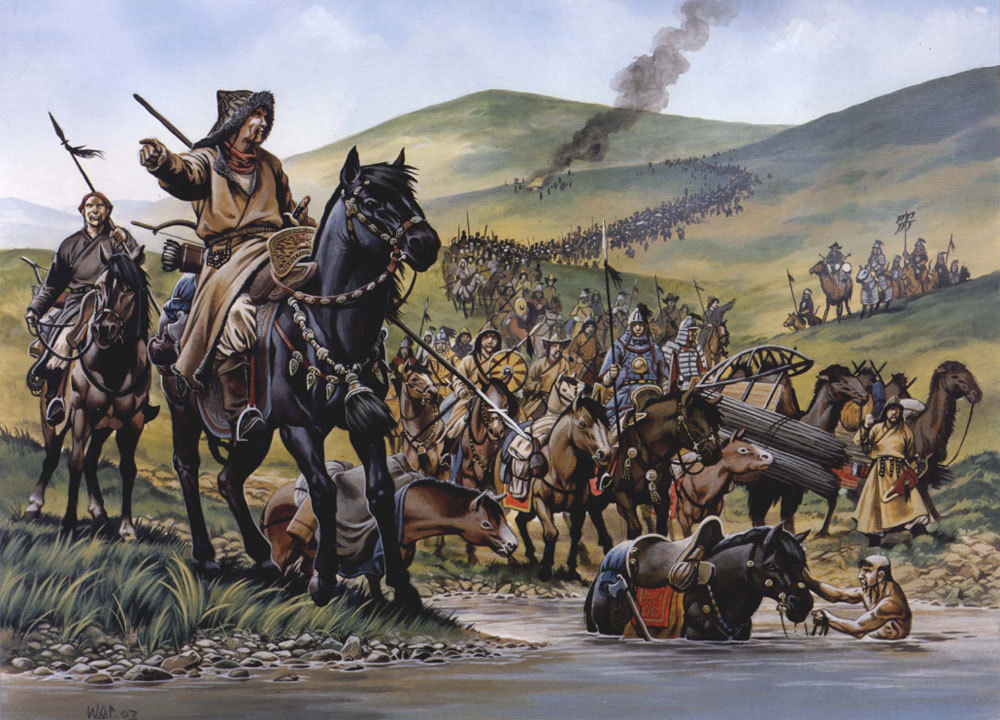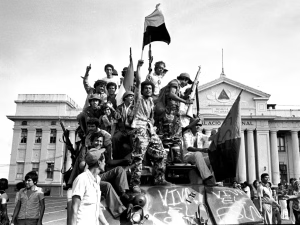The sun-scorched coast between Morocco and Egypt may look like endless emptiness today, but in 1940 it was the most direct land bridge that linked British imperial power (through Egypt and the Suez Canal) to the oilfields of the Middle East and, beyond them, to India and Australia. Hitler understood that starving Britain of Middle-Eastern oil and shutting the canal would bend the empire until it broke, while Mussolini dreamed of a renewed Roman Mare Nostrum across the Mediterranean. For London, holding Egypt meant keeping the empire’s jugular vein intact—and keeping the door open for a future Allied return to Europe through Italy. In short, every kilometre of sand suddenly mattered.
🚚 Supply Lines & Logistics
Before the shooting started, nature had already chosen sides. Temperatures in summer climbed above 45 °C (113 °F), engines choked on dust, and a sandstorm could blind an entire brigade. All fuel, food, and water had to be hauled hundreds of kilometres over rough tracks. Italian and later German convoys relied on a single vulnerable chain of ports—from Tripoli in Libya to a modest anchorage at Benghazi—while the Royal Navy and Royal Air Force struck at those supply ships from Malta and Alexandria.
The British coined the phrase the “100-mile screwdriver”: on a flat horizon a tank crew could literally see a repair truck 100 miles away, nothing in between but mirage. Thus, both armies learned to live on wheels—armoured cars roamed like mounted scouts of old, and maintenance units became as decisive as infantry.
Insert Image: A desert maintenance unit repairing a Crusader tank beside a tent.
Caption: “Fighting sand as much as the enemy—mechanics at war.”
⚔️ Operation Compass
When Italy declared war on 10 June 1940, Marshal Graziani pushed timidly into Egypt. His fortified camps near Sidi Barrani looked strong on paper, yet the British Western Desert Force (just 36 000 men and 275 tanks) noticed the Italian outposts were isolated and undersupplied. In December the British struck first. Operation Compass—a five-day “raid” that grew into a full offensive—broke through, pocketed entire divisions, and chased the Italians 800 km west in ten weeks. By February 1941, 130 000 Italian prisoners, 400 tanks, and 1 300 guns had fallen into Allied hands.
London celebrated “Churchill’s first victory,” but the desert chessboard was far from settled. Hitler had no plans for North Africa—until the Italians begged for help.
🏰 Siege of Tobruk
Tobruk’s natural harbour, cut into Libya’s coastline, let the Royal Navy resupply under a shield of coastal artillery. When General Erwin Rommel’s newly arrived Afrika Korps punched across Cyrenaica in March 1941, most of the British 8th Army withdrew—but 35 000 Australians, Poles, Indians, and British soldiers dug in around the port. For 241 days Tobruk refused to fall, defying Rommel’s blitzkrieg aura and blocking his shortest route to Egypt.
Defenders became legendary “Rats of Tobruk,” living in caves, daytime heat, and nightly mortar duels. RAF “Blenheim” bombers and Royal Navy “Tobruk ferries” slipped in supplies after dark. Although the garrison was relieved in December, the siege proved that Rommel’s logistics—and reputation—were not invincible.
Insert Image: Australian infantry in limestone trenches at Tobruk, smiling for a newsreel camera.
Caption: “The ‘Rats’ hold the line: life inside a besieged fortress.”
🏎️ Rommel Arrives
Rommel, hand-picked by Hitler, landed in Tripoli with fresh PzKpfw III & IV tanks. Ignoring high command’s caution, he struck immediately in March 1941, reclaiming Cyrenaica and trapping the British at Bardia and Mechili. Not yet possessing enough men or fuel to finish the job, he created the legend of rapid “end runs” around the desert flank—using the open sands like a sea to envelop slower opponents. German 88 mm guns, originally designed for flak, shredded British Matilda tanks at long range.
Yet the more ground Rommel gained, the farther he stretched his supply columns back to Tripoli—an Achilles heel the Allies would exploit again and again.
🛡️ Operation Crusader
By November 1941 the rebuilt 8th Army, now reinforced with South Africans, New Zealanders, and the fast Crusader tank, launched Operation Crusader. The plan was ambitious: pin Rommel’s armour with tank brigades, swing an infantry hammer through the desert door, and relieve Tobruk. For three confused weeks tanks clashed in sandstorms, commanders lost radio contact, and positions changed by the hour. Both sides suffered roughly 800 tanks knocked out.
The Allies emerged exhausted but ahead—Tobruk was relieved, Axis forces withdrew to El Agheila, and London believed the momentum had shifted. But Rommel’s knack for surprise had not.
🔥 Gazala Line & the Fall of Tobruk
Early 1942 Rommel struck back. He outflanked the Gazala defensive “box” system, exploited a pocket nicknamed “the Cauldron,” and by June encircled Tobruk for a second time. This time the fortress fell in a single day—35 000 prisoners lost, a shock that sent Churchill hurrying to Washington. Rommel surged to the Egyptian border, capturing Mersa Matruh and pushing to El Alamein, just 100 km from Alexandria. Cairo prepared evacuation plans; half-buried mines and booby-trapped whisky bottles lined the Nile Delta roads.
Insert Image: Burning fuel dump at Tobruk, black smoke towering above the harbour.
Caption: “Axis high-water mark: Tobruk in flames, 21 June 1942.”
🎯 First & Second Battles of El Alamein
1st Alamein (July 1942)
General Claude Auchinleck halted Rommel by anchoring on the Qattara Depression, where impassable salt flats denied flanking manoeuvres. The line held, but Allied counter-punches lacked weight and coordination. Both armies dug in through the blistering summer.
2nd Alamein (Oct–Nov 1942)
Enter Lieutenant-General Bernard Montgomery. He rebuilt morale, standardised training, and stockpiled 1 000 tanks, 900 field guns, and overwhelming air cover. On 23 October an artillery barrage lit the night “like the flicking on of an immense light switch across the desert.” Infantry cleared mine belts (“Devil’s Gardens”), engineer bulldozers opened corridors, and in early November armoured corps burst through.
Rommel, suffering from jaundice and critically short of fuel (thanks to Ultra code-breaking and Royal Navy interdiction), could not plug every gap. On 4 November he ordered a retreat that soon became a rout all the way to Tunisia. Churchill announced, “Before Alamein we never had a victory; after Alamein we never had a defeat.”
Insert Image: Desert night sky streaked with tracer as Allied guns open 2nd Alamein.
Caption: “The ‘light switch’: Montgomery’s opening salvo, 23 Oct 1942.”
✈️ Air & Naval Power over the Mediterranean
While tank duels grab the headlines, victory in North Africa was sealed from above and sea. RAF squadrons flying “Kittyhawks,” “Hurricanes,” and later “Spitfires” won air superiority by mid-1942, strafing supply convoys by day, while Wellington bombers hunted Axis ports by night. The tiny, battered island of Malta—subjected to more tonnage of bombs than London in 1940—survived to become an unsinkable aircraft carrier astride Rommel’s shipping lane.
On water the Regia Marina (Italian navy) never mustered the decisive sortie Mussolini boasted about; fuel shortages and radar-less ships were no match for British cryptanalysis and submarines lurking off Sicily. By autumn 1942, only 30 % of Axis supplies dispatched from Italy reached front-line depots—the rest lay on the seabed or burned on dockside craters.
Insert Image: RAF ground crew re-arming a Spitfire in Maltese camo, with bomb-scarred buildings in background.
Caption: “Malta endures—air power that starved the Desert Fox.”
🌐 International Dimensions
North Africa’s ranks read like a global census: Indian sappers clearing mines; Maori battalions leading bayonet charges; Free French brigades under General de Monsabert assaulting Bir Hakeim; Greek commandos raiding airfields at Heraklion; and U.S. Sherman tanks (arriving after “Operation Torch”) rumbling across Algeria. Even the Long Range Desert Group included New Zealanders, Rhodesians, and British Yeomanry navigating by stars across unexplored dunes.
Civilian morale mattered too. Egyptian railway workers secretly sabotaged tracks, Libyan tribes guided British patrols, and in Germany mothers mailed parcels of winter socks to sons sweating in 50 °C heat. War propaganda back home painted the desert as a glamorous duel—“Rommel vs. Monty”—masking the brutal slog of wounds, thirst, and sand-goggled marches.
🏆 Outcome & Legacy
The fall of Tunisia in May 1943 yielded 275 000 Axis prisoners—nearly as many as Stalingrad—effectively ending German presence in Africa. Strategically, the Allies gained three priceless prizes:
- A springboard into Europe. Sicily was invaded two months later, opening the Italian campaign.
- Secure oil and the Suez Canal. Britain’s lifeline to Asia stayed intact.
- A proof of Allied cooperation. Britain, the Commonwealth, Free French, and—after Torch—U.S. forces learned to combine air, sea, and land power under unified command, rehearsal for Normandy.
Rommel’s myth survived—as a master of mobile warfare shackled by fuel—but so did lessons of logistics, code-breaking (Ultra), and the emerging dominance of air power that would define later campaigns.
📸 Visiting the Battlefields Today
From the restored gun pits of El Alamein to Tobruk’s war cemetery lined with eucalyptus trees, North Africa still whispers of 1942. Museums in El-Alamein display armoured wrecks half-consumed by rust; Italian stone statues remember soldiers who never saw home again. Guided tours trace Rommel’s HQ caves at Marsa el-Bregh. Respect local regulations—many areas remain sensitive military zones or contain unexploded ordnance.
Insert Image: Memorial headstones under a setting sun at El Alamein War Cemetery.
Caption: “Silence after the storm: honouring those who fell in the desert.”
🏁 Conclusion
The North-African Campaign proved that desert sands could burn as fiercely as any European battlefield. It taught armies to think in supply tonnage, not just heroics, and showed that coalition warfare—when well supplied and well led—could roll back the Axis tide. From the desperate stand at Tobruk to the thunder of El Alamein’s guns, “Fire on the Desert” forged a pathway that ultimately led the Allies back into continental Europe and toward final victory in 1945.









































